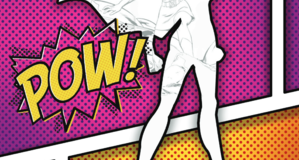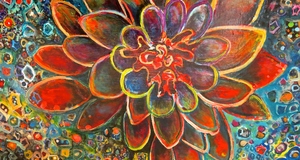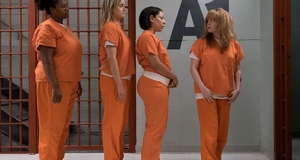Featured Article:Superheroes, Superpowers, and Sexuality
By
2010, Vol. 2 No. 10 | pg. 3/3 | « Powers and AttributesInherent vs. Gifted PowersThe way the superheroes’ sexuality is promoted is evident even unto the powers that they wield, and how they gained said powers. The different kinds of powers and the way in which they are used are strictly divided between the male and female heroes. The women heroes are rarely ones to have inborn powers; they are usually gifted to them. Exceptions to that are most typically alien, such as Hawk Girl whose wings are caused by her alien divine ancestry. For the other women, their powers and attributes were given to them. Wonder Woman was created by the gods of Greece for a mother who wished desperately for a daughter. Her powers were a gift from the gods of the pantheon. Catwoman’s strength, speed, and thievery skills were taught to her by a karate sensei and a boxer, both of whom she was introduced to by a third party. She worked her butt off during her training, but it was still an integral part of the story that she did not get to where she was by herself, she had help. The men on the other hand have inherent powers. Superman’s strength, speed, and flight are integral to his being because he is Kryptonian and is absorbing our sun’s rays. Spiderman has a little radio-active spider to thank, but he created the web-slinging devices on his own to give him the ability to sling webs to catch people and make webs. Batman must have learned his judo, karate, and Tai Kwon Do from somebody, but whomever it is, they are never mentioned in the stories. It is implied that he accomplished everything on his own.The difference between the genders and their powers seems to be important. Men have implied powers, yet women don’t, and the women’s powers were often gifted to them by males. This seems to be a playing out of the scenarios in real life regarding women’s liberation. Women were trying to break into a male dominated social world by demanding first voting rights and then equal employment and other rights. Yet each time the women have demanded another right, it has always been the men that have given it to them. When Selina Kyle, Catwoman, wants to learn to defend herself, a man gives her the tools to do so. When Themyscira, the Amazon island, needed a heroine, the gods (specifically masculine) blessed Diana, Wonder Woman, to be “Wise as Athena, stronger than Hercules, swift as Hermes, and beautiful as Aphrodite” (www.dccomics.com). The women are shown to have a subservient role to the men. However, when college age women whose favorite superhero was female were asked why the female superhero was their favorite, they frequently replied because the hero was female, or because she was female in a male dominated field. This shows that although the women are getting their powers from the male society, they are still an inspiration for women to go out there and get power for themselves. Kinds of PowersThere are definite exceptions to these rules, such as the X-Men. They are a whole team of heroes who received their powers in the same way, by genetic mutation and evolution. In cases like these, an analysis of the powers themselves show the gender roles which the heroes follow. The females on the team have powers such as telekinesis, weather control, matter phasing (where she can walk through solid matter), and a super sonic voice to name a few. These are what I like to call defensive powers, they are not designed to take the offensive, but to react to an attack with a force field, etc. The men on the team have burning lasers that shoot from their eyes, an Adamantium skeleton and super healing, super strength, an armored shell, etc., all designed for the offensive, to take the initiative and attack. This power division can be seen on many teams, such as the Fantastic Four, which has the Invisible Woman (force fields and invisibility), Mr. Fantastic (super stretchy), The Human Torch (flame on!), and the Thing (super strength, and made of rock). This separation of the kinds of powers implies that the women should defend, the men attack. The place for the female is behind the male with the super strength and such, and watching his back with a force field. Together they make a complete team, separately they are only offense or defense. That seems to be a common theme in life for humans in general. What is a more ingrained institution than marriage? A man and a woman work together to make a family, and each concentrate on different aspects of the family to make it run. Frequently (at least in the era when these superheroes were created) the woman’s powers reside in the home, while the man’s are at work, the man’s offensive on the world, the woman’s defensive. So the superhero division of powers both confirms and perpetuates that same division. Heroes and RelationshipsThere are codes in life and society that people follow very closely, as anthropologist Clifford Geertz explored in his essay on thick description (Geertz 1973). Though Geertz was examining the wink and what it means to burlesque a wink, the same theories of examination can be applied to the romantic relationships of superheroes. There are certain codes that even heroes must follow to be socially acceptable. When Campbell was examining the roles of the hero, he found that “the hegemony wrested from the enemy, the freedom won from the malice of the monster, the life energy released from the toils of the tyrant Holdfast – is symbolized as a woman” (Campbell, 1968, pg 342). This is clearly evident in the lives of Batman, Superman, and Spiderman. In each case, rarely an adventure goes by in which they are not saving the damsel (or damsels) in distress and then sleeping with them. Superman and Spiderman each eventually marry their girlfriends and Batman floats between girls because he’s such a loner, but has one steady love, Catwoman. There has yet to be a male superhero falling in love with, or dating, another male. It just hasn’t happened. That is one of the unspoken codes that dictates a superhero’s love life. The superhero can sleep with as many women as he likes, and Batman seems to take that to heart, but they dare not sleep with any other males. This would seem like an indication that society does not wish to openly acknowledge homosexuality, instead make heterosexuality the attractive aspect. Little boys grow up saving Lois Lane (Superman’s love) and Mary Jane (Spiderman’s love), while little girls pretend to be Mary Jane and Lois. They are taught at an early age by these role models that heterosexuality is the way to go. Now when we observe the female superheroes’ love lives, we are presented with a completely different picture. There is rarely ever a heroine who gets married. Wonder Woman has a few affairs, the most notable one being with Superman, Catwoman has the on again, off again relationship with Batman, and the only truly happily married woman in hero land is Jean Gray from the X-Men, and she married her co-worker Cyclops only after a rather nasty love triangle involving Wolverine. This implies that a woman who takes the initiative and tries to make it in this male-centric job set is forced to give up part of her femininity. She can not make it to the alter as a bride and she does not have children even when she manages to make it to the wedding. While male superheroes can and do have children (however short lived they may be due to villains), female superheroes seem not to be capable of giving birth. This cripples their sexuality for they are making the ultimate female sacrifice to be a hero; motherhood. So while their bodies, costumes, and mannerisms may scream femininity, they seem to not be able to have a steady relationship or have children. The unspoken codes of the female are broken by the heroine’s lack of the maternal aspect. ConclusionRaised on images of buxom women and studly men, who spout definite ideals about what the perfect man or woman is, our cultural ideals laid out in complete exaggeration, how can we not expect our children to emulate and eventually perpetuate these ideals on the next generation? The women are shown as overly curvaceous, subservient, and relationship impaired, but strong and capable because of all of these aspects and the men are shown as strong, intelligent, forthright, and true, protectors of the weak and small. It is as Campbell says; the hero is defined and defines society, and the sexuality and gender roles that the Superheroes of ours and our parents’ time symbolize are evident in how our society works and functions (Campbell, 1968). Women are given power and status by the men who hold control, men in power can have healthy families and relationships while many women sacrifice their home life for a successful career. And the children see this as the hero rescues thousands, and the adults write of this as a hero defeats the enemy and emerges victorious, and the cycle rolls on. ReferencesCampbell, Joseph. 1968 The Hero With a Thousand Faces. Princeton; Princeton University Press. DC Comics. DC Comics Secret Files. Electronic Document, http://www.dccomics.com/secret_files/, accessed December 6, 2005. Geertz, Clifford. 1973 The Interpretation of Cultures: Selected Essays. Basic Books. Lamb, Sarah. 2000 White Saris and Sweet Mangoes. Berkley; University of California Press. Marvel Comics. 2005 Marvel Universe. Electronic Document, http://www.marvel.com/universe/index.htm, accessed December 6, 2005. Martin, Emily. 1992 The Woman in the Body: A Cultural Analysis of Reproduction. Boston; Beacon Press Miller, M., Austen, C. 2002 Ultimate X-Men Vol. 3: World Tour. New York; Marvel Comics. Miner, Horace. 1956 The Body Ritual of the Nacerima. American Anthropologist, New Series, Vol. 58, No. 3, 503-507. Robbins, Richard H. 2006 Cultural Anthropology; a Problem-Based Approach [ed. 4]. United States; Thompson Wadsworth. Suggested Reading from Inquiries Journal
Inquiries Journal provides undergraduate and graduate students around the world a platform for the wide dissemination of academic work over a range of core disciplines. Representing the work of students from hundreds of institutions around the globe, Inquiries Journal's large database of academic articles is completely free. Learn more | Blog | Submit Latest in Sociology |
















